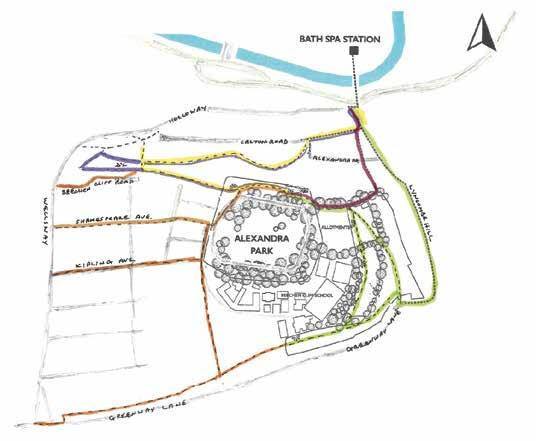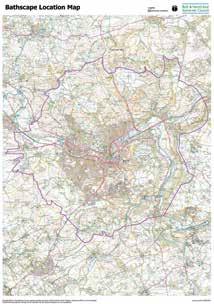
5 minute read
A conversation with the NT
The National Trust cares for 700 acres of land across Bath including ancient woodlands, wildflower-rich hay meadows and permanent pastures, which are part of the traditional farmed landscape. We talked to Joe McSorley, National Trust Area Ranger for Bath, to find out how the land is managed and how local people can help protect and support this much-loved landscape.
How much of the National Trust land in Bath is farmed?
Advertisement
Most of the land on the Skyline is farmed at various points during the year and has been for centuries. Half is managed with a tenant farm business and the other half, including the pasture at Prior Park Landscape Garden, is let out for grazing to farmers with whom we work to maximise the variety and abundance of flowering plants.
What benefits does farming provide to the Skyline?
Grazing is a really important tool in maintaining species-rich wildflower meadows, which provide a link in the food chain for bees, hoverflies and butterflies – themselves a food source for birds and small mammals. We graze with low numbers of livestock and only for part of the year to reduce dominant grasses and to let light and moisture through to dormant wildflowers.
Bath Skyline is popular with dog walkers, but do you face any challenges from this?
On the whole everyone walking their dogs is mindful it’s farmed land, but the lambing season (February to May) is always a worry. Even the best-behaved dogs can stress sheep and running in the sheep fields can lead to lambs being miscarried. In addition, a small number of walkers don’t clear up after their dog or leave full poo bags by trees and gates for others to dispose of, and we’d encourage everyone to do their bit by taking waste and litter home.
Is there a calendar for when livestock are on the Skyline?
Sheep are around all year but generally not in dog-accessible fields. Cattle are around from late April through to October in the permanent pastures such as Bushey Norwood and Rainbow Wood Fields. In the hay meadows, they’ll come in after the hay cut in August and will graze until October. Sheep graze Richens Orchard from September to December, and we close the gates at this time, ensuring fruit from the trees are in buckets near the gates for people to help themselves. ■ Colette
Hill
Exploring our Bathscape
While Bathscape might not be the most elegant of words it does perfectly encapsulate the role of the Heritage-Lottery funded partnership scheme set up to help us explore, understand and restore Bath and its environs.
Bathscape manager Dan Merrett explains: ‘the work we do can be summarised under three broad headings – improving our environment, encouraging people out to enjoy our unique landscape, and providing resources, training and events to help people get the most out of it.
The ‘Bathscape’ itself encompasses the green setting of the City of Bath World Heritage Site, and stretches from Charmy Down in the north to Combe Hay in the south, from Corston in the west to Kingsdown in the east. Just three paid employees – Dan Merrett, senior projects officer Lucy Bartlett and volunteer coordinator Julia Kennaby – run a jaw-dropping array of projects, executed by an 800-strong army of volunteers. At time of writing, the website (bathscape. co.uk) was calling for more, including walk leader volunteers to lead wellbeing walks or help with the walking festival; community action volunteers to help plant trees, plant wildflower meadows, or maintain footpaths; views and vistas volunteers to research and share the best viewpoints such as Bathwick Fields or Beechen Cliff; and conservation volunteers to build bug habitats and bird boxes or collect wildflower seeds (those collected from the meadows south of Smallcombe Wood have been distributed over new sites from the ha-ha below Royal Crescent to Innox Park north of Bath City Farm).

The Bathscape website is a treasury of useful information. There is a monthly podcast, Footprints (https://footprints.captivate. fm/), which is also available on Apple podcasts, Amazon music and Spotify. There are articles https://www.bathscape.co.uk/ learn/ on a whole range of topics from the story of Ralph Allen’s house and garden at Prior Park to the 15 species of bats that can be found ‘in one of the best bat hotspots in the country’. There are self-guided walking trails from Sensory Smallcombe to Bath’s Best View at Alexandra Park (https:// www.bathscape.co.uk/activity/more-selfguided-walking-trails/) and more walks created by the Widcombe Association https://www.bathscape.co.uk/activity/ widcombe-association-6-self-guidedwalks/
The initiative is made possible by the support of Bathscape’s many partners from the council and Wessex Water to Bath Spa University and the University of Bath. Funding is secure until at least 2025, which is just as well as there is still so much to do.
■ Colette Hill
Living on the Edge at Butt Ash
We are very fortunate to need wellies round here – getting down and dirty outdoors is a wonderful thing – and here in Widcombe we have easy access to all kinds of lovely mud - in the garden or along the canal, up in the fields in Smallcombe and Widcombe or through the woods. Throw in a dog (responsibly) and, in my humble opionion, you have the best possible day out.
My family and I are lucky - we live close to the centre of Widcombe and not only do we share our space with a dog, but alpacas, pygmy goats, some sheep and hens as well. Many of you will be familiar with Zippy –our youngest alpaca who until recently was a regular contributor to these pages (in response to concerned Widcombe residents he is still here and happily chewing the grass – but he’s working on his first novel which is taking longer and more crayons than anticipated).
Lots of people pop their heads over the wall to watch what’s going on in the field and we always try and wave back. It’s a great way for us to meet people and for people to watch the animals at close quarters.
Of course, sometimes we get calls from concerned locals – a heads-up to a dead sheep in the field. We always check, but said ovine is thankfully usually napping after a hard morning’s grazing, and rarely (and by rarely, I mean never) says thanks for the wake-up call.
In general, though, the relationship between town and country is harmonious. I think our animals out in the field are part of the wider Widcombe family and, like any family, each member is different and each has its own personality. Spending time with them teaches us a lot about ourselves and is actually surprisingly calming – it’s quite difficult to worry about human things while the alpacas are arguing (again) about which feed bucket is theirs, or Barry the goat is trying to eat all the carrots.
FAQs (yes, they are frequently asked)
I love seeing your lambs in the spring. How long have you had them?
That’s not us – try Nick’s flock further up Ralph Allen Drive. Or maybe an optician??
Are they llamas? Or alpacas?
These are alpacas – an easy way to remember is that ‘llama’ rhymes with ‘banana’. Llamas have banana-shaped ears, whereas alpacas have cute, floofy, straight ears and are generally much more attractive and better tempered than their more rustic counterparts (Zippy might have hacked this answer).
I love pygmy goats. They’re adorable, right?
Two of them are – one pushes his luck!
Would you be up for bringing one of the alpacas to the Ring O Bells for my friend’s birthday one night?
No. They are not circus animals, they like to stay together at all times and we don’t have that kind of public liability insurance. This is without consulting the management at the Ring O’Bells who I’m pretty sure would repeat what I’ve just said.
How about children’s parties?
See previous answer.
■ Biddy Walcot
An easier walk to the top of the world
In Widcombe, you are just 10-15 minutes walk to Bath’s best viewing point at Alexandra Park. But too many walkers follow Google maps, struggling up the steep steps of Jacob’s Ladder. Far better to wander the newly-improved paths along Beechen Cliff Woods or choose the step-free route via Lyncombe Farm Fields and past the elegant villas of Lyncombe Hill. With that in mind, the WA is working with Bathscape, the Council, Lyncombe Hill Fields, and Alexandra Park to consider options for signs to guide walkers towards the kinder options for making the climb.■ Helen Peter







